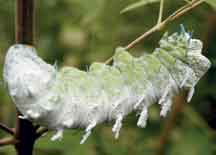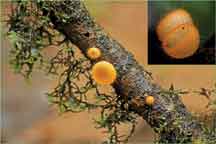Gowri Shankar and Sharmila
“You will find something more in woods than in books. Trees and stones will teach you that which you can never learn from masters.” ~St. Bernard
 If one were given the freedom to actually observe and listen one would learn more. Take ants for example. The only time possibly that children learn about ants is when they are asked to read the story of The ant and the grasshopper. After the moral of the story is explained, however, the chapter is closed. Closing the chapter too soon denies kids the opportunity to look closer. Children could learn more by actually watching the ants work together, the way they build nests, clean and defend themselves from other ants, and predators and how efficiently they rebuild a destroyed nest. There are also ant-plant systems where a host plant provides shelter and food to its partner ants, who in return protect the host plant from herbivores.
If one were given the freedom to actually observe and listen one would learn more. Take ants for example. The only time possibly that children learn about ants is when they are asked to read the story of The ant and the grasshopper. After the moral of the story is explained, however, the chapter is closed. Closing the chapter too soon denies kids the opportunity to look closer. Children could learn more by actually watching the ants work together, the way they build nests, clean and defend themselves from other ants, and predators and how efficiently they rebuild a destroyed nest. There are also ant-plant systems where a host plant provides shelter and food to its partner ants, who in return protect the host plant from herbivores.
Similarly a wasp, which is most often squashed with a textbook by kids, can teach them about co-evolution. A classic example is the relationship between a wasp and a fig tree. Unless the queen wasp squeezes herself into a tiny cavity of the fig to lay eggs, the figs can never pollinate and the wasp’s eggs have a safe place to hatch. This makes each one indispensable for the other’s survival. Certain species of wasps keep the spider population under control. A digger wasp or mud dauber wasp stings spiders to paralyze them after which they lay eggs on the prey. Once the hatchlings emerge they have a larder full of food to eat and grow. In just one column from a nest of a mud dauber wasp we found 26 spiders (of the same species)!
Algae, fish, frogs, insects, fungi, plants, trees, reptiles, birds, mammals, water, climate, and us, we are all connected. Tropical rainforests are said to be almost a 100 million years old. The forest floor, understory, canopy and emergent layers form the four layers of a rainforest. Each layer compliments the other. The soil is poor in nutrients but decomposing animal and plant matter, a rich source of nitrogen, help support the gigantic trees in the rainforest. Unique adaptations in the form of shallow roots, thin and smooth barks, and “buttresses” help increase the surface area, hence the breathing capacity of these trees. Their leaves are thick and waxy to tolerate heavy rains; they also have a special feature called “drip tips”, which ensures that rain water reaches the layers below. Vines and lianas network between the layers. Orchids, ferns and bromeliads are epiphytes that grow on trees but do not depend on them for nutrients. Each of these layers supports a wide array of fauna.
 Nature offers a plethora of lessons to learn from, it is up to us to give it and us a chance to look, see and learn. It is common to see Nature camps crop up every summer. This is great, but it sends out a wrong message that observing Nature and learning are things done when other ‘important’ things are completed. Teachers hold the mantle to change this notion.
Nature offers a plethora of lessons to learn from, it is up to us to give it and us a chance to look, see and learn. It is common to see Nature camps crop up every summer. This is great, but it sends out a wrong message that observing Nature and learning are things done when other ‘important’ things are completed. Teachers hold the mantle to change this notion.
Here are few ways in which teachers could sensitize children and inculcate the habit of observing and learning from Nature, so that it becomes their second nature:
- First educate yourself through books, by attending Nature camps and develop a keen sense of observation, patience, and eagerness to learn.
- Start small. Begin by creating small groups with 100% participation. Begin the day with an interesting fact or observation for kids to do the same day. E.g., identifying an ant or watching a plant hopper on a leaf. Then progress by assigning activities that children can do every day for a few minutes.
- Create daily and weekly activities that would take just few minutes a day.
E.g.,Butterflies are great insects of encouragement. If food is provided they make their appearance. The groups could maintain two plants, one flowering plant for nectar and one food plant for butterflies to breed. They could also strategically place food like sugar syrup, rotten vegetables or fruits to attract these colourful insects. This activity will help kids learn about plants, the life cycle of butterflies, and encourage them to observe butterflies even outside school. - Invite nature into your classrooms. The next time you want to clean up the corners of the wall try to leave one or two spider webs alone for the kids to observe. Take a break from a rigorous session on trigonometry to watch the spider weave a web, to see its quick movements to wrap the trapped insect. This makes for good learning just as much as trigonometry.
- Help kids understand their environment. Go on nature walks around the school campus, even if it is not a sprawling 3-4 acre land; just going out of the classroom aids learning. If your school is in a busy metropolitan city with vehicles zooming past, you can still observe urban birds and their adaptations. Watching through a pair of binoculars from the school terrace you could observe a myna feeding its chicks inside a broken street light, or a black kite manoeuvring its tail and feeding while flying, or a moth caterpillar cocooning itself on a wall of your terrace.
- Take help from experts. Arrange for nature walks either by inviting them to your school or by attending nature workshops and camps. These provide opportunities to learn right things from the right people. These experts have dedicated their lives to studying biodiversity. Gain from their knowledge, and with their help see things in a perspective like you have never seen before. Understand current situations, the research underway and find a way to do your bit in your daily lives.
Everything boils down to becoming aware, opening up and being creative in helping children look beyond books and into a world teeming with life around them. With proper guidance and knowledge children will begin to not just observe and learn but to respect life.
The authors are a couple who share a common interest in herps and a life in the rainforest. Based at Agumbe, Karnataka, they run an organization called the Centre for Rainforest Ecology. They hope to empower action through environmental education and state of art scientific training in wildlife field studies. They regularly conduct workshops and camps through which they create awareness, and support other NGOs with similar goals. They can be reached at info@rainforestecology.com. You can also visit their website www.rainforestecology.com and blog: http://www.pogirigowrishankar.wordpress.com/.

